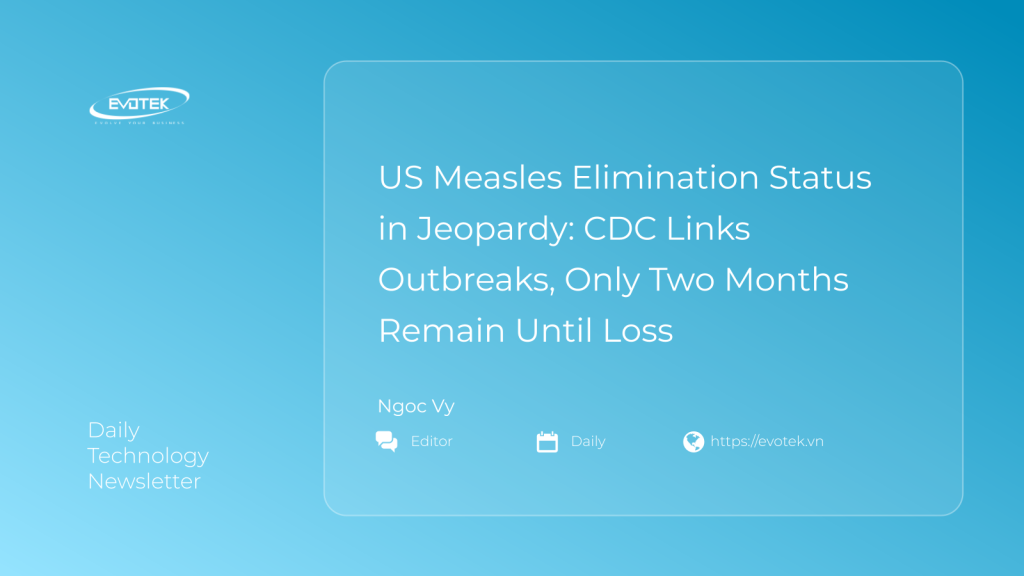The United States is on the precipice of a significant public health reversal, just two months away from potentially losing its measles elimination status. Federal health officials, according to a revealing report by The New York Times, have conclusively linked two major US measles outbreaks, indicating a concerning continuity of the virus’s spread across the nation.
Critical Link Confirmed: A Decade-Long Status at Risk
During a confidential call with state health departments, the Centers for Disease Control and Prevention (CDC) confirmed a critical epidemiological link: the current measles outbreak spanning the Arizona-Utah border is a direct continuation of an earlier, explosive outbreak that originated in West Texas in mid-to-late January. This confirmation is pivotal, as both widespread incidents are attributed to the identical measles virus subtype, highlighting an unbroken chain of transmission.
This previously unreported connection is highly significant, especially amidst ongoing inquiries from journalists and growing concerns among health experts, compounded by Canada’s recent loss of its own measles elimination status. Should the U.S. follow suit, measles would once again be categorized as endemic within the country. This would represent an alarming and embarrassing public health setback, particularly for a disease that is entirely preventable through vaccination.
Escalating Case Numbers and the 12-Month Threshold
The initial large-scale outbreak in Texas, which commenced in late January, officially concluded on August 18, tallying 762 confirmed measles cases. Subsequently, Arizona and Utah began experiencing cases in June, with a significant surge observed in August, leading to a combined total of 212 reported cases across these two states.
This crucial epidemiological link signifies approximately ten consecutive months of measles circulation within the United States. If the identified measles virus subtype, known as ‘9171,’ persists in spreading beyond the 12-month threshold, specifically into January 2026, the U.S. will officially forfeit its elimination status. This coveted designation, achieved in 2000 following arduous, decades-long vaccination initiatives, requires a full 12 months without continuous domestic transmission. Its loss signals the re-establishment of persistent circulation.
Obstacles to Containment: Low Vaccination and Public Health Challenges
This escalating situation comes as little surprise to those on the front lines. David Sugerman, who spearheads the CDC’s measles response, remarked on the call that the ‘9171’ subtype “continues, unfortunately uninterrupted, across multiple jurisdictions,” underscoring the relentless nature of its spread.
Local health officials express profound pessimism regarding their ability to halt the virus’s spread, citing “limited” impact from vaccination campaigns. As previously reported, critical measles hotspots, including northwestern Mohave County, Arizona, and Utah’s southwest health district, exhibit dangerously low vaccination rates. For the 2024–2025 school year, kindergarten vaccination coverage stood at a mere 78.4 percent and 80.7 percent in these areas, respectively. These figures fall significantly short of the 95 percent threshold required to achieve community immunity and prevent sustained transmission.
Further exacerbating the crisis, public health agencies in Arizona and Utah encounter significant operational barriers. Approximately a quarter of all measles cases cannot identify their exposure source, suggesting potential missed cases and broader community spread. A particularly troubling incident in late October saw a suspected measles patient in Salt Lake County, Utah, refuse to cooperate with investigators, impeding their ability to confirm the probable infection.
David Kimberlin, a distinguished member of the expert panel tasked with reviewing the United States’ measles elimination status, conveyed a stark outlook to The Times: “It would not surprise me in the least if there’s continued spread across these next several months,” he stated, underscoring the formidable challenge ahead.
A 33-Year High: Alarming Statistics
The CDC’s latest figures are alarming: 1,723 measles cases have been recorded across 42 states this year. A staggering 87 percent of these cases are tied to the 45 outbreaks reported nationwide. For critical context, the U.S. saw only 16 outbreaks and a total of 285 cases in the entirety of the previous year. This year’s surge represents a sobering 33-year high for measles infections in the country.

 日本語
日本語 한국어
한국어 Tiếng Việt
Tiếng Việt 简体中文
简体中文